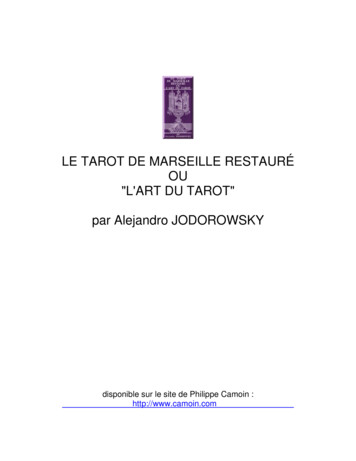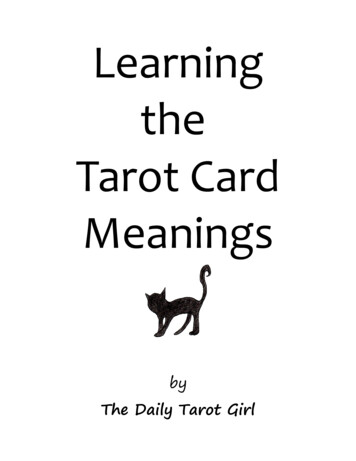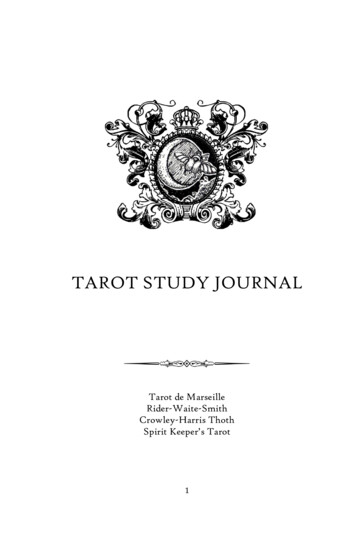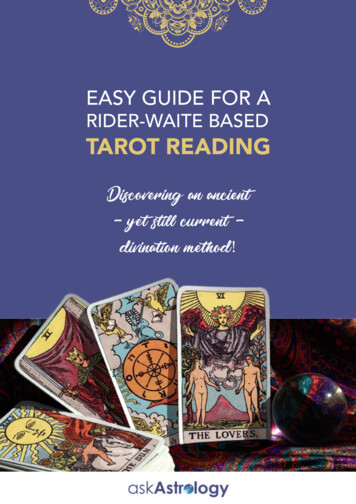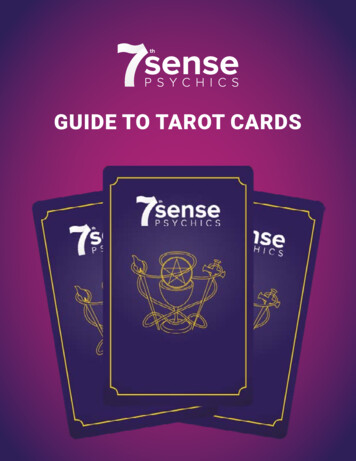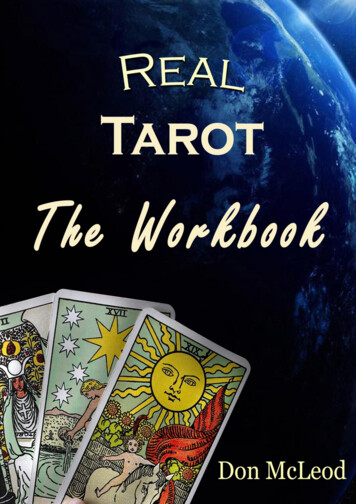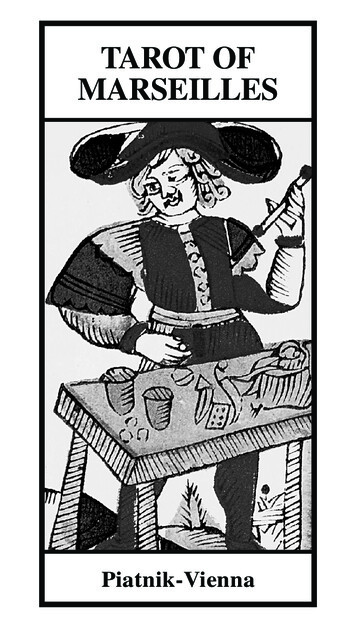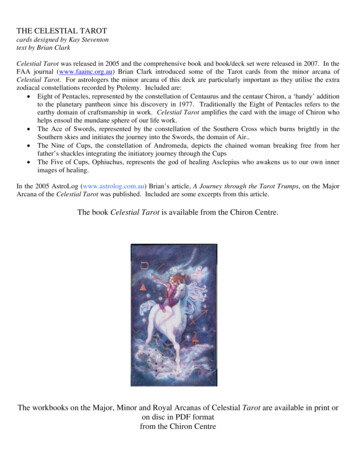
Transcription
THE CELESTIAL TAROTcards designed by Kay Steventontext by Brian ClarkCelestial Tarot was released in 2005 and the comprehensive book and book/deck set were released in 2007. In theFAA journal (www.faainc.org.au) Brian Clark introduced some of the Tarot cards from the minor arcana ofCelestial Tarot. For astrologers the minor arcana of this deck are particularly important as they utilise the extrazodiacal constellations recorded by Ptolemy. Included are: Eight of Pentacles, represented by the constellation of Centaurus and the centaur Chiron, a ‘handy’ additionto the planetary pantheon since his discovery in 1977. Traditionally the Eight of Pentacles refers to theearthy domain of craftsmanship in work. Celestial Tarot amplifies the card with the image of Chiron whohelps ensoul the mundane sphere of our life work. The Ace of Swords, represented by the constellation of the Southern Cross which burns brightly in theSouthern skies and initiates the journey into the Swords, the domain of Air. The Nine of Cups, the constellation of Andromeda, depicts the chained woman breaking free from herfather’s shackles integrating the initiatory journey through the Cups The Five of Cups, Ophiuchus, represents the god of healing Asclepius who awakens us to our own innerimages of healing.In the 2005 AstroLog (www.astrolog.com.au) Brian’s article, A Journey through the Tarot Trumps, on the MajorArcana of the Celestial Tarot was published. Included are some excerpts from this article.The book Celestial Tarot is available from the Chiron Centre.The workbooks on the Major, Minor and Royal Arcanas of Celestial Tarot are available in print oron disc in PDF formatfrom the Chiron Centre
THE EIGHT OF PENTACLES:CentaurusWith the Eight of Pentacles we enter the sphere of Chiron, the wise andhumble centaur whose name is derived from the root meaning ‘hand’.Unlike the other wild and barbaric centaurs Chiron’s instinctual sidewas channelled into being masterful and ‘handy’, skilled in thepreparation and application of herbs and tinctures. Recognised as botha teacher of the ancient wisdom and as a natural healer Chiron taughthis apprentices the sacred heroic arts with great respect for thetraditions of the Earth. Through attention to detail, persistence anddedication to his craft, his heroic students learned to engage the soulthrough their life’s work. When this card appears the individual isapprenticing, called by an inner voice to practically apply their skillsand talents to a work in progress. With the Eight of Pentacles thesphere of work is in the process of developing, the craft is beingmastered and the skills are being sharpened. The individual is moredirected and dedicated as their occupation is becoming more alignedwith their soul. This card confirms that the individual is in touch withtheir vocation and focusing on developing that.The constellation Centaurus is one of the larger southern constellations linked with Lupus (The Two of Swords)and Ara (The Eight of Wands) in a trinity of devotional sacrifice. At the altar of the gods Chiron offers up the wildbeast Lupus symbolising the sacrifice of the bestial and primitive aspects of the self in service to the divine. Hencethe constellation has also been linked to another Centaur Pholus, who like Chiron was gentle and served the gods.Neither was born with the race of the other Centaurs who were wild, savage and unruly.Chiron and Pholus, while still Centaurs and beasts, are cultured and refined representing the civilisation andeducation of primitive instincts. The Eight of Pentacles reveals that raw materials and primal energy have beenshaped and used in the pursuit of satisfying work.Chiron has often been mistaken as the centaur in theconstellation of Sagittarius. Zeus placed Chiron in the constellation of Centaurus after he voluntarily exchanged aplace in the underworld with Prometheus, releasing the hero from his torturous imprisonment. Chiron had beenaccidentally wounded by the deadly arrows of Heracles that had been infected with the terminal toxins of theHydra’s blood. As the son of Cronus he was immortal yet the arrow had punctured the flesh of his lower animalnature, which was excruciatingly painful. Zeus permitted Prometheus to go free in exchange for Chiron andtherefore both were freed from the cycle of pain. Chiron represents the interconnection between the instinctual and
the divine which often results in the spirit-body split. However his myth reminds that both are intertwined and theEight of Pentacles reveals that the individual is mastering the creative spirit through his or her work.While we are most familiar with Chiron in his role as the wounded healer he was the chthonic deity whosymbolised the ancient ways of healing and heroism in the Greek myths. As a hybrid he represented a vestige ofthe ancient link to the earth, its magic and its healing potentials. To his cave on Mount Pelion young boys whowere orphaned, disenfranchised, and abandoned would come to train as heroes. Their tuition included reverencefor the gods, the arts of healing, herbs, and homeopathy, astral divination and astronomy, skills at archery andcombat as well as the arts of civilisation. In his presence the young would be trained to become skilled, masters oftheir profession. Here in the mountainous cave Chiron gave Jason his name which means healer. Here he taughtAsclepius the healing arts and Heracles astral divination. Chiron underlies the Eight of Pentacles and when thecard appears the individual metaphorically is in the tutelage of Chiron training to be masterful and skilled at whatthey do. Like its namesake the atmosphere of the constellation is devotional and the message of this card suggeststhat the sphere of work needs to be united with meaning. When the card appears the individual is challenged tofind fulfilment in what they do and the soul in their everyday routines.Saturn, the ruler of the second decan of Virgo, was the mythological father to Chiron. However in the myth neitherparent was available to raise Chiron and as an embodiment of an archetype he identifies with what is marginal,disenfranchised and excommunicated.However these are the very souls that Chiron fosters and mentorssuggesting that this energy has an ability to reshape the damaged aspects of one’s self. Chiron’s healing is throughacceptance, not through triumphing over the wound or fixing it.acceptance of what is misshapen and cannot conform.His healing balm is applied through theTherefore when the card appears it signals the need toaccept our skills and talents the way they are, not to try to force them to conform to a standard shape or align themwith someone else’s ideal form. Chironic craftsmanship is forged out of perfecting of the innate raw material.Astrologically the combination of Saturn and Virgo speak about the need for attention to detail, autonomy at work,the need for self-discipline and structure. Both need practical application and also suggest precision and excellenceof craft. Saturn acknowledges work well done and the appearance of this card reveals the need to attend andpersist with the project. Chiron’s nature is also a maverick and therefore the appearance of the card encourages theindividual to be more accepting of what they identify as misshapen or marginal in the system, as this is thewellspring of creativity and spirit. On an oracular level the Eight of Pentacles heralds an encounter with a mentoror teacher who inspires our vocation in a practical and useful way. Metaphorically the individual has reached thecave of Chiron, a transitional place where the sacred and the mundane can be interwoven through craftsmanshipand spiritual work.
THE ACE OF SWORDS: CrusisInitiating the journey into Swords is Crucis or Crux the smallest of allthe constellations. Commonly known as the Southern Cross, Crusiscontains four stars in the shape of a cross that burn like a bright torch insouthern skies. For nations like Australia, Brazil and New Zealand thestars of the Southern Cross are emblematic of their place in theSouthern Hemisphere as the constellation is not visible at the majorityof northern latitudes. In antiquity these four stars were part of theconstellation of Centaurus and at that time were visible in the NorthernHemisphere.However, due to the precession of the equinoxes, theshifting of the heavens has meant that the constellation has disappearedfrom northern skies.Synchronistically, from a Euro-centricperspective, the last era when Crux appeared in the northern firmamentwas at the latitude of Jerusalem during the time of Christ. The image ofhis crucifixion has remained the most powerful icon in Europe makingthe cross one of the most commonly recognised symbols in westerntheology.In the last quarter of the 17th century the Southern Cross became recognised as a separate constellation. Ptolemyand his predecessors had catalogued the four stars as belonging to the Southern Centaurus. From the sacred groundof Chiron the celestial cross evolved into its own star pattern. Due to its proximity to the celestial pole the cross isone of the constellations, which circumnavigate the South Pole. In Celestial Tarot the Ace of Cups represents theconstellation of the Lesser Bear, a northern circumpolar constellation. As the polar constellations both these Acesrepresent the polar processes of heart and mind. With the Ace of Cups the journey into feelings begins symbolisedby one of the most ancient totems of the goddess, the bear. With the Ace of Swords the power of the mind isawakened to begin the journey into the mental realm with the discovery of new ways of thinking. Seminal ideas, theapplication of discrimination and will, and fresh insights reshape how we define the truth.Both Aces inrepresenting circumpolar constellations also symbolise the human poles of instinct versus reason and the cosmicaxis of the Earth Goddess and the Heavenly Father.The Ace of Swords depicts the sword emerging out of the heavenly cross, a contemporary religious symbol, yetalso the ancient symbol of the Earth. The cutting edge of the sword symbolises consciousness beginning toseparate from Gaia, or from the body and its instinctive life. With this card the initiation into objectivity, logic,rationality and consciousness of the other is beginning to occur. Through the process of separation from the objectconsciousness begins to dawn, however with consciousness the pain of being separate is awakened. Therefore thiscard implies the ambivalence of becoming conscious; on one hand we are enlightened in discovering the truth, yet
on the other hand this discovery may bring conflict and pain. The Ace of Swords represents the duality embeddedin becoming consciously awakened.In the Southern Hemisphere the cross is easily identifiable and therefore has become animated with the projectionsof southern folklore. To the Wairao a Venezuelan tribe, the star pattern is a celestial bird with bright feathers thatprotects their children. Sheltered under the bird’s vast plumage the children are safe from dark spirits and evilforces. Symbolically the bird is a link between heaven and earth and a messenger of the gods. It is a creature ofthe air and is a totem for this element and the suit of Swords. This folktale reminds us of the mystical andprotective power of the mind embodied by this celestial bird. When the Ace of Swords appears it suggests usingthe healing aspects of the mind to protect oneself from negative patterns of thought. The card signifies that theemergence of new patterns of thought, different viewpoints and ideas are threatening the old way of being. Truthas it was once known is changing through the experience of becoming more mature and aware. The intellect isbeing sharpened, discrimination is heightened, and perceptions are clearer; all challenge the old way of knowingthings. Conflict is natural during the transition and the card reminds the individual to utilise the affirming power ofthe intellect to resolve the schism.Astrologically the cross is a potent image of both conflict and resolution. The aspect pattern of the ‘grand cross’involves the conflicted angular arrangement of four or more planets. Each planetary archetype is in a tensealignment, yet through the management of this tension balance is possible. The cross of matter relates to the fourangles of the horoscope and their different orientations to life. And embedded in the wheel of the year and thezodiac are the four cardinal points which represent the beginning of a new season or phase of being. One of thesecardinal points is Libra the sign that oversees the Ace of Swords. Libra and its ruler Venus, goddess of this firstdecan, both suggest that resolution to conflict or opposition comes through clarity and balance of perceptions, theability to weigh and judge situations, the facility to see both sides of a situation and the gift of being able tonegotiate and compromise in order to reach the truth. Libra also represents strategy and the ability to detach fromemotional responses and reactions long enough to be able to see them in perspective. It is the only inanimate signof the zodiac and one of the guardians of the equinox when the night and day forces are evenly balanced.Instinctually its urge is to balance, weigh, judge to arrive at the most enlightened perspective. Libra abhors thedarkness of ignorance and suggests the conception of a new phase of social learning. Venus the brightest planetalso rules over this card and symbolises the brightening of the mental faculties and the commitment to a moreenlightened way of knowing. On an oracular level the Ace of Swords suggest that clarity and discrimination arenow necessary, as a new pattern is constellating and the old order is being questioned. When this card appears itsuggests that new strategies are emerging to birth a progressive way of understanding the current situation.
THE NINE OF CUPS:ANDROMEDASince antiquity Andromeda has been a muse for many poets, authors, vase painters and playwrights as the mythicmotif of the woman in chains rescued by the hero stirs the imagination. This figure of the Chained Woman hasbeen consistently projected onto the eponymous constellation. She is princess to the prince Perseus in the court ofher father King Cepheus and mother Queen Cassiopeia; all four representing neighbouring constellations, whichastronomers have categorized as the Andromeda Group. How these constellations came to represent this dynastymay have been revealed in Euripides lost play named for the heroine.Andromeda’s myth of the sacrificed virginal daughter of the king has many parallels in Greek myth. AfterPoseidon had labored building the walls of Troy the king Laomedon failed to appropriately honour the god for histoil. Raging at being unacknowledged Poseidon sent a sea-monster to ravage the land. The oracle’s solution to ridTroy of Poseidon’s monstrous plague was to sacrifice Hesione, the king’s daughter, who was then chained to a cliffand rescued by the hero Heracles. Similarly Iphigenia, the innocent daughter of King Agamemnon, was sacrificedin order for the curse of Artemis to be lifted. With the Nine of Cups we encounter the figure of vulnerableAndromeda who had been chained to the rock as a sacrifice for her father and his kingdom.Underlying the images of the myth lay the ancient tradition of the sacred marriage. Andromeda’s name ‘ruler ofmen’ is the Greek title for the ancient tradition of the queen, the surrogate of the goddess Astarte, who weds thehero after he destroys the primal monster. Along the ancient shores where Andromeda was chained to the rock, thegoddess was worshipped in temples to the local deity Atargatis. Earlier the constellation had also been associatedwith Astarte by the Egyptians. Therefore the image of Andromeda as the sacrificial victim of the latter Greekstories belies her powerful link to the goddess Astarte whose cult was continuous in the ancient world. The Greeksknew her as Aphrodite the power of love. However her introduction to Greek myth through Homer’s epic TheIliad stripped her of her power. Aphrodite is now the daughter of Zeus, not the potent and primal goddess born outof the sea foam the generation before him from the severed genitals of the sky god. Her chaotic, exotic and eroticnature is now subject to ridicule and disrespect. Like Aphrodite Andromeda’s myth became reduced to thedaughter of the king rescued by the hero. However a powerful tradition linking her to the great goddess of loveand desire underpins her classical myth of the sacrificial daughter. When the Nine of Cups appears it brings thispowerful tradition of the sacred marriage and the power of love to conscious awareness reminding us of thesacrifices of feelings we make when denying the potent goddess of desire. While the myth illustrates the sociopolitical repression of feminine power and its affect on the collective psyche there is also a personal parallel.When the feminine power of personal feelings is sacrificed to an outer authority or tradition we may feel chainedand imprisoned.
THE FIVE OF CUPS:OPHIUCHUS, The Serpent BearerOphiuchus means ‘he who holds the serpent’ and to the ancient Greeks the serpent bearer was Asclepius, placed inthe heavens by his grandfather, Zeus, who was responsible for also striking him down with one of his lighteningbolts. Later myth suggests the reason for his demise was that Asclepius had restored life to fallen heroes.Resurrecting the dead infuriated Pluto, the god of Death, who demanded Zeus retract Asclepius’ immortality. Itwas Apollo, Asclepius’ father, who petitioned Zeus to resurrect his son and place him in the constellations toeternally honour his healing legacy. Today Ophiuchus reminds us of the Greek God of Healing whose cult in theancient world developed alongside Hippocratic medicine. Two streams of medical practice existed in the ancientworld, one sacred and the other secular. The card illustrates Asclepius holding the caduceus. The intertwiningserpents symbolise panacea, the god’s ability to cure all sickness; a motif used in cultures even more ancient thanthe Greeks.Scholars have traced the image of the caduceus back to the design on a sacrificial cup of aMesopotamian king. But the Five of Cups reminds us of the ancient Greek king, Asclepius, both hero and Godwho is petitioned during time of illness.To the ancients illness was a divine calling, the disease being the god’s way of making the soul’s malcontentknown through the body. In contemporary psychological thought this is the parallel of psychosomatic illness, thebodily symptom serving as the voice for psyche’s ills. This illness prompted the ancient Greek to make apilgrimage to one of Asclepius’ sacred healing sanctuaries. The healing temples were the touchstone for ourcontemporary healing and psychotherapy clinics. Once the patient arrived at the sanctuary of Asclepius theyprepared themselves for their encounter with the healing god through cleansing rituals of bathing and fasting.Priests guided them through the labyrinthine way to the temple where the patients laid down in the sacred spaceand fell asleep in anticipation of a dream. It was in the dream where the visitation of the god of healing, generallyin the guise of a serpent appeared to activate the healing process. This ritual alerts us to the necessity to createenough sacred space in our lives to attend to the soul’s needs.Asclepius is often deemed the founder of the medical tradition which he inherited from his divine father Apollo.The legendary physician Hippocrates honoured this tradition by claiming an ancestral link to Asclepius. Howeverin the Asclepian tradition the medical remedy was not prescribed by the doctor but fostered through contact withthe patient’s internal psychic images, honouring the potency of self-healing and the imaginal processes. Like manyheroes Asclepius was raised by Chiron who mentored the young god in the arts of medicine, herbalism,homeopathy and surgery. It was Hermes who brought Asclepius to the wise centaur’s cave after he had beenrescued from the womb of his dead mother. Apollo had sentenced his mother Coronis to death for infidelity. Asshe lay burning on the funeral pyre Apollo realised it was his child in her womb and summoned Hermes to rescuethe unborn child, Asclepius. Snatched from the clutches of death Asclepius’ miraculous birth allowed him to
survive to become the god of healing, echoing the shamanistic motif of the healer called to his vocation through hisown suffering and encounter with death. Like a shaman Asclepius also had the power to retrieve the souls from therealm of the dead. The goddess Athena bequeathed two vials of the Gorgon’s blood to Asclepius; one vial of bloodfrom the right side of the body restored life while the other vial from the left side of her body brought death.Asclepius personifies the mysterious amalgam of wounding and healing.Asclepius healed the sick by creating a therapeutic space where images from the unconscious could be honoured,activating the healing power of the psyche released through dream images. This along with the respect for thepatient’s internal psychological processes allowed the soul to be restored to health. With the Five of Cups we meetthis powerful daemon that reminds us of the rich and creative inner world of dreams and symbols. The seconddevelopmental phase of Scorpio is ruled by Neptune, the astrological symbol that confirms the urge to embrace theDivine. Neptune’s presence with the Five of Cups suggests we are in the internal realm of the imagination, longingto encounter the Divine.However, we must be aware that the language of the soul reveals itself throughparadoxical images and magical symbols. A sacrifice to the gods of one’s ego identity is also necessary. With thiscard surrender to the ego’s way of knowing facilitates entry into the soulful domain of divine possibilities. Withthe combination of Scorpio and Neptune we are pulled into other inner world of fantasy, the dream and theimagination in order to restore well being.The Five of Cups depicts Asclepius calling us to the inner sanctuary because the split between soul and body haswidened and the imbalance may ignite a healing crisis. Surrounding him are the five cups, which suggest acreative outcome to the process, the healing symbol of Scorpio and the glyph for Neptune, symbolising theimaginative process of the divine.Wounding is an archetypal aspect of the individuation process and theaccompanying emotional pain scars the soul. Drawing this card alerts us to the possibility that well being may berestored. First the wounded feelings, the sense of disappointment, and the pain of suffering must be acknowledged.Secondly we need to journey to a sacred space to honour the soul with the intention of embracing the inner worldof psyche and her images. The Five of Cups draws us into the liminal space between the wounding and the healingwhere we can restore our sense of self through interaction with the gods of the imagination. When this cardappears we are beckoned into this inner realm to awaken our own healing images.
0THE FOOL: Uranus, Herald of ChangeInnocent and unaware of the initiations and lessons lying aheadthe Fool is poised to step into the unknown to begin hisunfolding journey into self-understanding, ready to follow adream, a hunch or a sign wherever it may lead him. His card isnumbered zero, as he is outside the ‘pack’, marginal to theincarnate world of form and substance, still spirit with unlimitedpotential and endless possibilities. Not yet encumbered withpossessions or weighed down by earthy attachments the fool isfree to explore the new world in front of him. In the Tarot theFool demarcates the conception and emergence of a new spirit ofbeing.In The Celestial Tarot the planet Uranus is the daimon guiding the Fool. The cosmic power of Uranus is suddenand unexpected, disembodied and future-directed, uprooting the past to make way for progress. Preferring spiritualideals and altruistic principles Uranus inspires the individual to take a risk and rebel against the status quo.Uranian energy disengages from attachments seeking a world of perfection, possibility and utopia. Seekingfreedom in its encounters and space in its environment the Uranian atmosphere can feel disconnected. Separationis a hallmark of this archetype as its urge to progress and willingness to jump into new adventures is far greaterthan its need to remain static. While this need to separate is motivated by the urge to discover the self, others mayexperience it as pushing away, disengaging, cutting off or being aloof. Attachments, routines and possessions mayfeel suffocating therefore the individual responds defensively to find their space and separateness. Uranianseparation is not necessarily literal as in a separation from a person, a place or a career. The separation may befrom old habits and programs, past thought patterns or ways of being, generally experienced as a relief since itliberates time and energy to pursue new paths. When Uranus unexpectedly bursts into our life it significantly altersour everyday reality. While the journey may often feel like a roller coaster ride the path that unfolds leads togreater self-awareness and authenticity.Until the late eighteenth century Saturn marked the boundary of our Solar System. In 1781 amidst an atmosphereof revolution (i.e. the French, American and Industrial Revolutions) the planet Uranus was discovered heralding anew order of science, industry and technology. Like the Fool Uranus was marginal to the pack of visible planets.Uranus’ discovery led to a new political ethos which challenged tyranny and suppression. Uranus ushers in theNew Age of Aquarius, an age whose ideals are devoted to equality and freedom for all, as well as the liberation ofhuman rights and truths.
When the Fool appears it suggests a new age filled with unexpected changes, a fresh start with challenges lyingahead. The atmosphere is charged with the electricity of excitement and the thrill of adventure. Anything ispossible. The card suggests the most effective way to meet the challenge is with open arms, faith, innocence andthe willingness to be in the moment to be led in any direction. On a divinatory level the card symbolises aspontaneous approach to life, a leap of faith and the courage to let things happen by disengaging all forms ofcontrol. On an oracular level the appearance of the Fool suggests a turning point and a beginning. A redemptiveaspect of ourselves is urging us to change and become more authentic by stepping forward into a new adventure.ITHE MAGICIAN: The Mercurial GuideLeading the sequence of the Major Arcana is the Magician.Traditionally this card has evolved from earlier depictions of ajuggler and conjurer into later images of a magus and shaman,two extremes of the archetype governed by Mercury, thequicksilver messenger of the Gods. In The Celestial Tarot wemeet youthful Mercury ready to guide us through thelabyrinthine path ahead. Astronomically Mercury is the fastestmoving planet. Due to its speed the ancients likened it to theirfleet-footed god Mercury.Similarly alchemists named theeponymous element known for its quickness of movement.Astrologically the planet Uranus is the higher octave of Mercuryand both govern the intellect and its powers.HoweverMercury’s sphere is not as altruistic, often fraught with trickery,mischief and sleight of hand.Mercury is the surrogate of Uranus initiating the Fool into the game of life by endowing him with the skillsnecessary not only to play but also to outwit his opponents. The Magician reflects the ability to be in control of thesituation and direct it energetically in the appropriate direction. At hand are Mercury’s numerous gifts to navigatethe new territory.The Magician highlights the need to become conscious of goals as well as the will, ingenuity and intellect neededto pursue them. As thief, trickster and boundary crosser mythological Mercury is aligned with the tradition of theshaman. As a master of the occult Mercury has guided the evolution of knowledge and wisdom from the magicwielding seers of antiquity through the wonder-working alchemists of the Middle Ages to the artificial intelligenceused today. With knowledge we can inform ourselves, become more conscious of our goals and masterful with our
creations. This is the Magician’s role and when he appears it suggests the time to take charge of our life byconsciously creating something out of the possibilities surrounding us.Astrologically Mercury is associated with the process of learning, communicating, the sharing of ideas. It rulestwo signs, Gemini and Virgo, which reflect the duality and dexterity of Mercury’s approach to learning. Geminirepresents the quicksilver ability to gather and adapt ideas while Virgo digests and analyses information into acoherent formula. Along with other intellectual processes such as rationale, logic, reflection and communication,the Magician’s skills help us to understand our motives and urges educating us to not be solely reliant oninstinctual and subjective responses. Mercury allows the process of objectification to occur so separation can leadinto a broader social network. His skill is in guiding us to the right place, therefore when the Magician appears itstresses the need to be objective and conscious of the path ahead. Mercury is never static, always in motion and itis necessary to be flexible and open to generate the power to move forward.Youthful Mercury beckons us. As a patron of youth he reminds us that we are filled with possibilities and thepower to pursue them. On his head is his wide-brimmed traveller’s hat suggesting that we are about to embark ona journey. In his left hand is his herald’s wand. As a magician with knowledge of herbs, healing and hypnosis thestaff is also his magician’s wand used to induce a trance. Howeve
THE CELESTIAL TAROT cards designed by Kay Steventon text by Brian Clark Celestial Tarot was released in 2005 and the comprehensive book and book/deck set were released in 2007. In the FAA journal (www.faainc.org.au) Brian Clark introduced some of the Tarot cards from the minor arcana of Celestial Tarot. For astrologers the minor arcana of this .


